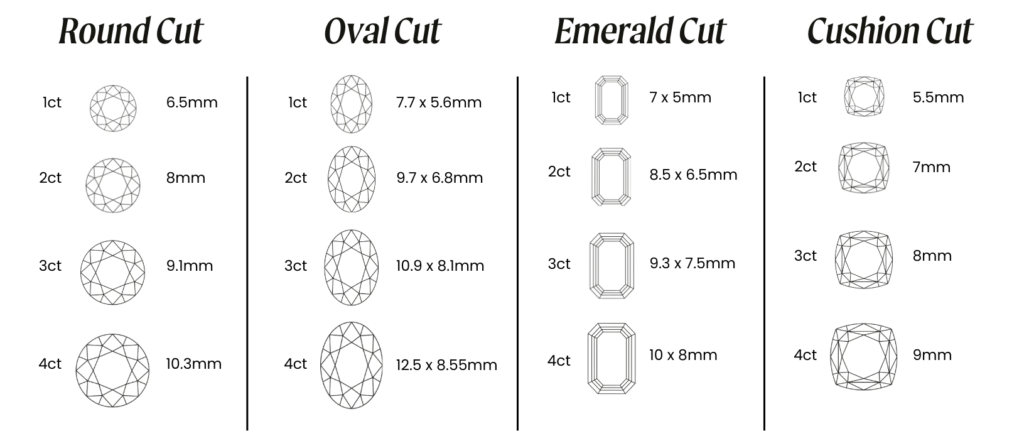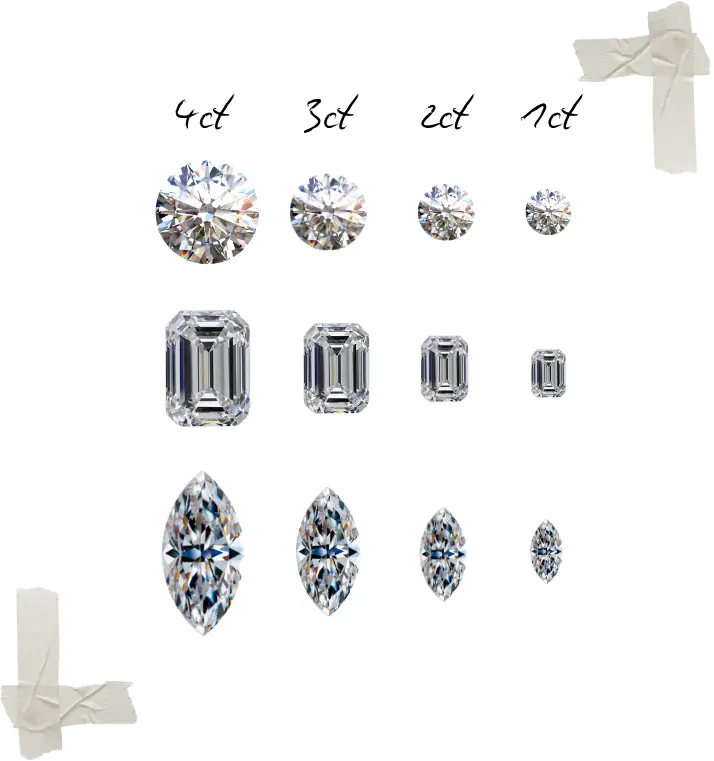Carat is more than just a number – it influences a diamond’s size, appearance, and price. Before you purchase a diamond, it’s important to understand how carat weight works, how it’s measured, and how it can vary in its visual impact depending on other factors like finger size, cut, and setting.
What is Carat Weight?
Carat refers to the weight of a diamond and is measured in metric carats. One carat equals 0.2 grams, which is roughly the weight of a paperclip. To provide even more precision, diamonds are measured to the hundredth of a carat, with each hundredth referred to as a “point.” For example, a 1.00-carat diamond has 100 points, while a 0.50-carat diamond has 50 points. Despite the association between carat weight and size, the physical dimensions of a diamond are influenced by its cut and shape, making carat weight just one piece of the puzzle.
The Difference Between Visual Size and Carat Weight
A diamond’s visual size can differ significantly from its carat weight, which is due to the way the diamond is cut.
A well-cut diamond, particularly in a round brilliant shape, optimises the way light reflects off its surface, often making it appear larger than its actual weight. On the other hand, a deep-cut diamond like an emerald may hide much of its weight in its depth, resulting in a smaller face-up appearance. With these diamonds we can use the measurements and properties of a stone to not only understand the carat weight but the ‘visual carat weight’ – whether it looks bigger or smaller than its actual weight on the finger.
The shape of a diamond also plays a role in how large it appears. Elongated shapes, such as ovals, marquises, and pears, can appear bigger than round diamonds of the same carat weight because of their greater surface area. Conversely, more compact shapes, such as cushions and princess cuts, might look slightly smaller despite having the same weight.

How Carat Weight Relates to Finger Size
Surprisingly, the size of your finger can also impact how a diamond’s carat weight looks. A one-carat diamond on a smaller ring size, such as size 4, will appear larger and more prominent than the same diamond on a size 8 finger. Similarly, the width of the band can also change the visual impact of the stone. A thin band draws more attention to the diamond and can make it look larger, while a wider band may downplay the size of the stone.
Want to play around with carat weights on your finger? Get our ring and diamond size kit for free here.
It’s always important to consider your band is wide enough to support the weight of your diamond to guard against damage: we’d never suggest less than a 1.8mm band at the bare minimum, and 2mm for anything larger than 2 carats.
And while there’s no strict maximum carat weight for a given finger size, practicality plays a role in ensuring comfort and balance. Larger diamonds, particularly those above three carats, may feel heavy or overwhelming on smaller hands and may require special settings to ensure security and stability.
The Relationship Between Carat Weight and Price
Carat weight has a significant impact on the price of a diamond, but it’s not a linear relationship. Prices increase disproportionately at certain “magic weights,” such as 0.50, 1.00, and 2.00 carats, because these weights are highly sought after. For instance, a one-carat diamond is often more expensive per carat than a 0.95-carat diamond, even though the size difference is almost imperceptible. Similarly, the jump in price from a 1.90-carat diamond to a 2.00-carat diamond can be substantial. Bananas, eh?
Clever buyers often choose diamonds just under these thresholds to maximise value without sacrificing visual size.
Carat Weight and Setting Choices
The carat weight of a diamond influences the type of ring setting you might choose. Larger diamonds, such as those above two carats, often do well in secure settings like six-prong solitaires or bezel settings, which encase the stone for added protection.
Smaller diamonds, on the other hand, lend themselves well to delicate solitaires, pavé bands, and vintage-inspired settings. These not only provide a balanced combination of practicality and prettiness, but also complements its carat weight, enhancing its overall look.
How Carat Weight Affects Appearance
The visual effect of carat weight varies depending on the dimensions of the diamond. For example, a half-carat diamond typically measures around 5.2mm in diameter, while a one-carat diamond measures approximately 6.5mm. A two-carat diamond expands to about 8.1mm, creating a dramatic difference in appearance compared to smaller stones. However, it’s important to remember that carat weight is just one aspect of a diamond’s overall beauty. A smaller, well-cut diamond can outshine a larger one with inferior proportions or clarity.
Lab-Grown Diamonds and Carat Weight
Lab-grown diamonds offer an affordable way to achieve a higher carat weight without breaking the bank. For example, a 1.50-carat mined diamond might cost between £10,000 and £12,000, while a comparable lab-grown diamond will be less than half that cost.
This price difference makes larger carat weights more accessible, allowing buyers to focus on the size they truly desire without compromising on quality or other factors.
Carat weight is an important factor in diamond selection, but it’s not the only one. The interplay between weight, cut, shape, and setting determines a diamond’s overall appearance and how it fits into your lifestyle. By understanding how carat weight affects size, comfort, and price, you can make a more informed decision that aligns with your personal preferences. At Adamas Studio, we specialise in helping you navigate these choices to find the perfect diamond for your unique story.
Ready to discover your ideal diamond? Explore our collection of lab-grown diamonds and let us guide you to the perfect carat weight for your dream ring. Book a consultation today!



